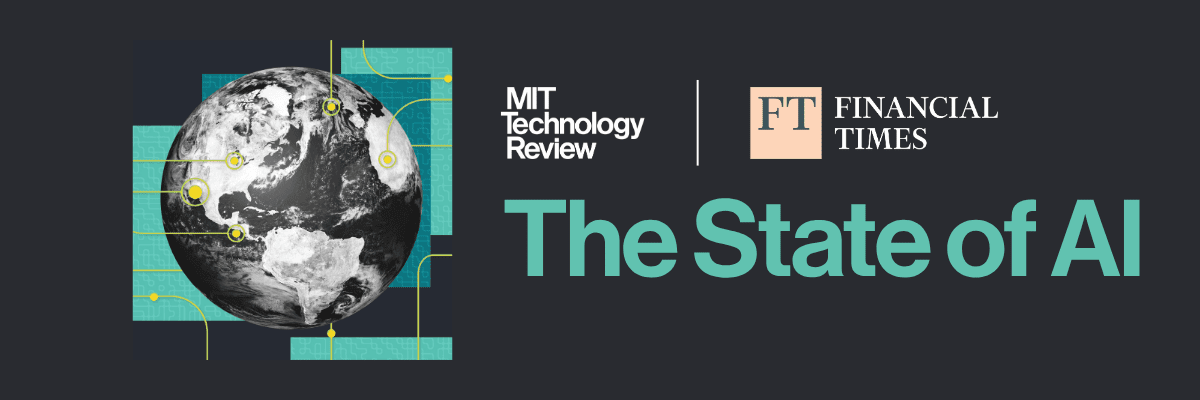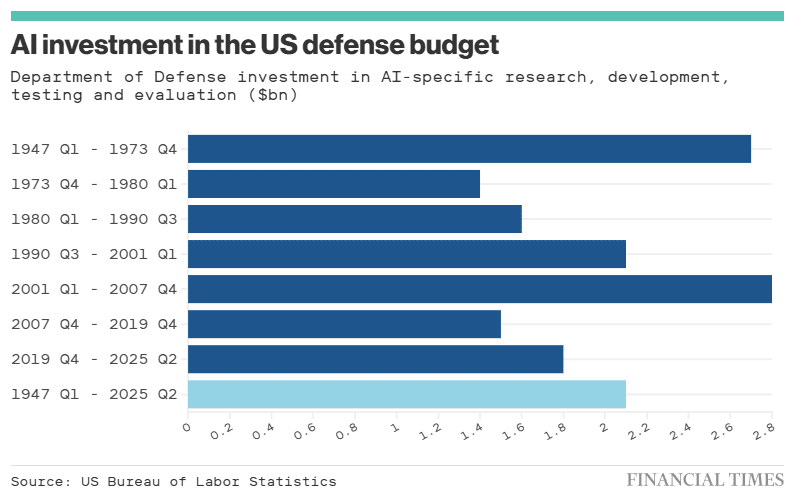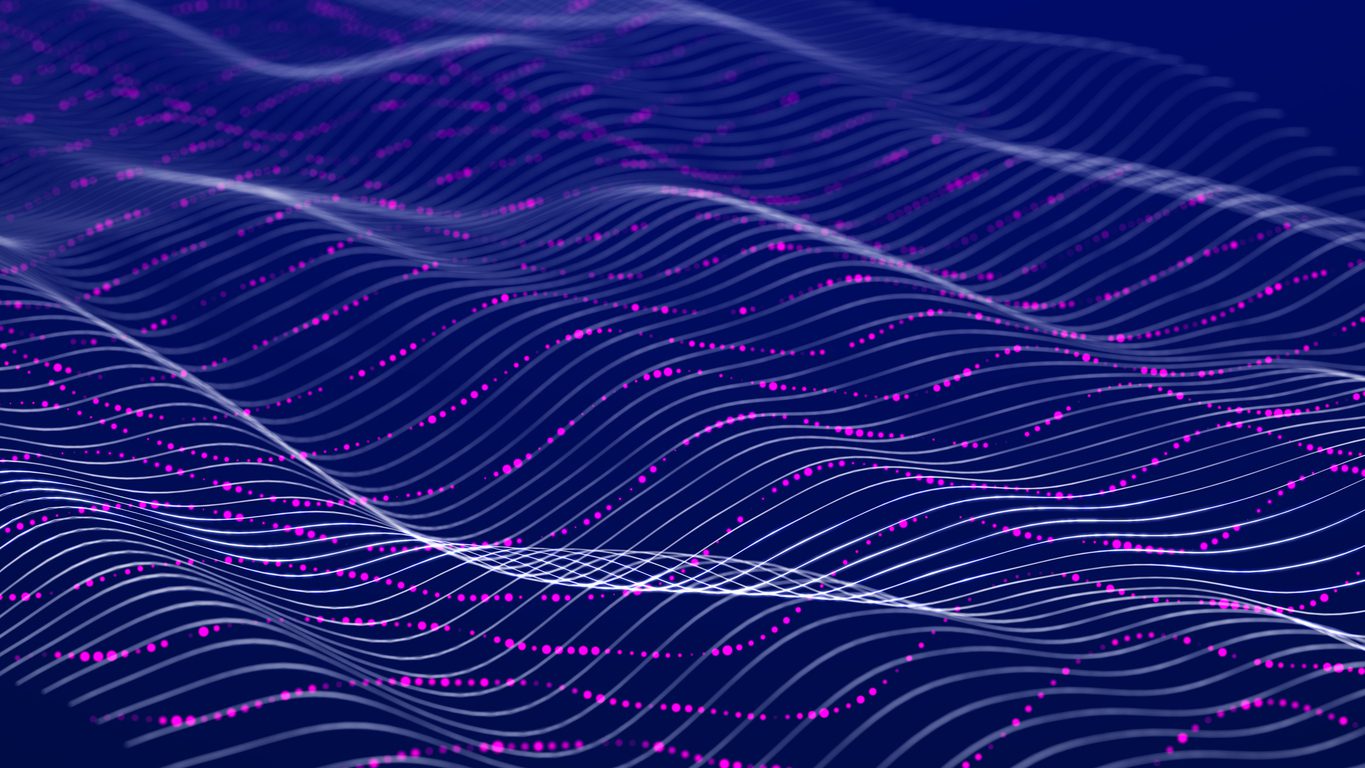The State of AI: Welcome to the economic singularity
Welcome back to The State of AI, a new collaboration between the Financial Times and MIT Technology Review. Every Monday for the next two weeks, writers from both publications will debate one aspect of the generative AI revolution reshaping global power.
This week, Richard Waters, FT columnist and former West Coast editor, talks with MIT Technology Review’s editor at large David Rotman about the true impact of AI on the job market.
Bonus: If you’re an MIT Technology Review subscriber, you can join David and Richard, alongside MIT Technology Review’s editor in chief, Mat Honan, for an exclusive conversation live on Tuesday, December 9 at 1pm ET about this topic. Sign up to be a part here.

Richard Waters writes:
Any far-reaching new technology is always uneven in its adoption, but few have been more uneven than generative AI. That makes it hard to assess its likely impact on individual businesses, let alone on productivity across the economy as a whole.
At one extreme, AI coding assistants have revolutionized the work of software developers. Mark Zuckerberg recently predicted that half of Meta’s code would be written by AI within a year. At the other extreme, most companies are seeing little if any benefit from their initial investments. A widely cited study from MIT found that so far, 95% of gen AI projects produce zero return.
That has provided fuel for the skeptics who maintain that—by its very nature as a probabilistic technology prone to hallucinating—generative AI will never have a deep impact on business.
To many students of tech history, though, the lack of immediate impact is just the normal lag associated with transformative new technologies. Erik Brynjolfsson, then an assistant professor at MIT, first described what he called the “productivity paradox of IT” in the early 1990s. Despite plenty of anecdotal evidence that technology was changing the way people worked, it wasn’t showing up in the aggregate data in the form of higher productivity growth. Brynjolfsson’s conclusion was that it just took time for businesses to adapt.
Big investments in IT finally showed through with a notable rebound in US productivity growth starting in the mid-1990s. But that tailed off a decade later and was followed by a second lull.



In the case of AI, companies need to build new infrastructure (particularly data platforms), redesign core business processes, and retrain workers before they can expect to see results. If a lag effect explains the slow results, there may at least be reasons for optimism: Much of the cloud computing infrastructure needed to bring generative AI to a wider business audience is already in place.
The opportunities and the challenges are both enormous. An executive at one Fortune 500 company says his organization has carried out a comprehensive review of its use of analytics and concluded that its workers, overall, add little or no value. Rooting out the old software and replacing that inefficient human labor with AI might yield significant results. But, as this person says, such an overhaul would require big changes to existing processes and take years to carry out.
There are some early encouraging signs. US productivity growth, stuck at 1% to 1.5% for more than a decade and a half, rebounded to more than 2% last year. It probably hit the same level in the first nine months of this year, though the lack of official data due to the recent US government shutdown makes this impossible to confirm.
It is impossible to tell, though, how durable this rebound will be or how much can be attributed to AI. The effects of new technologies are seldom felt in isolation. Instead, the benefits compound. AI is riding earlier investments in cloud and mobile computing. In the same way, the latest AI boom may only be the precursor to breakthroughs in fields that have a wider impact on the economy, such as robotics. ChatGPT might have caught the popular imagination, but OpenAI’s chatbot is unlikely to have the final word.



David Rotman replies:
This is my favorite discussion these days when it comes to artificial intelligence. How will AI affect overall economic productivity? Forget about the mesmerizing videos, the promise of companionship, and the prospect of agents to do tedious everyday tasks—the bottom line will be whether AI can grow the economy, and that means increasing productivity.
But, as you say, it’s hard to pin down just how AI is affecting such growth or how it will do so in the future. Erik Brynjolfsson predicts that, like other so-called general purpose technologies, AI will follow a J curve in which initially there is a slow, even negative, effect on productivity as companies invest heavily in the technology before finally reaping the rewards. And then the boom.
But there is a counterexample undermining the just-be-patient argument. Productivity growth from IT picked up in the mid-1990s but since the mid-2000s has been relatively dismal. Despite smartphones and social media and apps like Slack and Uber, digital technologies have done little to produce robust economic growth. A strong productivity boost never came.
Daron Acemoglu, an economist at MIT and a 2024 Nobel Prize winner, argues that the productivity gains from generative AI will be far smaller and take far longer than AI optimists think. The reason is that though the technology is impressive in many ways, the field is too narrowly focused on products that have little relevance to the largest business sectors.
The statistic you cite that 95% of AI projects lack business benefits is telling.
Take manufacturing. No question, some version of AI could help; imagine a worker on the factory floor snapping a picture of a problem and asking an AI agent for advice. The problem is that the big tech companies creating AI aren’t really interested in solving such mundane tasks, and their large foundation models, mostly trained on the internet, aren’t all that helpful.
It’s easy to blame the lack of productivity impact from AI so far on business practices and poorly trained workers. Your example of the executive of the Fortune 500 company sounds all too familiar. But it’s more useful to ask how AI can be trained and fine-tuned to give workers, like nurses and teachers and those on the factory floor, more capabilities and make them more productive at their jobs.
The distinction matters. Some companies announcing large layoffs recently cited AI as the reason. The worry, however, is that it’s just a short-term cost-saving scheme. As economists like Brynjolfsson and Acemoglu agree, the productivity boost from AI will come when it’s used to create new types of jobs and augment the abilities of workers, not when it is used just to slash jobs to reduce costs.
Richard Waters responds :
I see we’re both feeling pretty cautious, David, so I’ll try to end on a positive note.
Some analyses assume that a much greater share of existing work is within the reach of today’s AI. McKinsey reckons 60% (versus 20% for Acemoglu) and puts annual productivity gains across the economy at as much as 3.4%. Also, calculations like these are based on automation of existing tasks; any new uses of AI that enhance existing jobs would, as you suggest, be a bonus (and not just in economic terms).
Cost-cutting always seems to be the first order of business with any new technology. But we’re still in the early stages and AI is moving fast, so we can always hope.
Further reading
FT chief economics commentator Martin Wolf has been skeptical about whether tech investment boosts productivity but says AI might prove him wrong. The downside: Job losses and wealth concentration might lead to “techno-feudalism.”
The FT‘s Robert Armstrong argues that the boom in data center investment need not turn to bust. The biggest risk is that debt financing will come to play too big a role in the buildout.
Last year, David Rotman wrote for MIT Technology Review about how we can make sure AI works for us in boosting productivity, and what course corrections will be required.
David also wrote this piece about how we can best measure the impact of basic R&D funding on economic growth, and why it can often be bigger than you might think.







